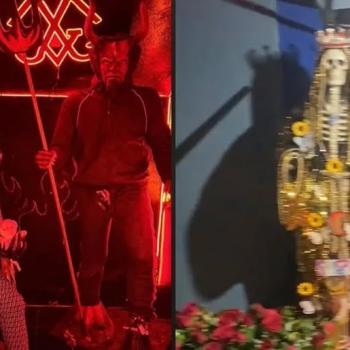Deep in the heart of Naples, where the tuff stone (a type of limestone typical of the area) meets collective memory, a cult survives—one that speaks not only of death, but also of connection, hope, and invisible justice. It is the cult of the ànime pezzentelle: poor, forgotten souls without names or histories who, thanks to a bond of popular piety, are adopted by the living. An intimate and communal gesture that intertwines spirituality, magic, anthropology, and material culture.
In Neapolitan dialect, pezzentella means poor, miserable, destitute. The ànime pezzentelle are, therefore, the souls of the nameless dead, unclaimed, buried in mass graves. A silent and invisible army of spirits who, according to popular belief, have not found peace because they were forgotten by loved ones—or perhaps never belonged to anyone at all.
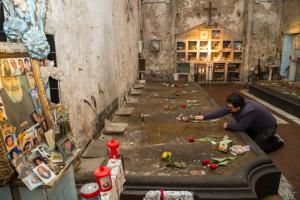
These souls wander through purgatory or limbo, awaiting someone to take responsibility for them. In Naples, however, death is a daily presence, part of both the symbolic and domestic landscape. Over time, these faceless souls have found people willing to listen. Most often, it is women—widows, elderly women, working-class women—who take on the care of these souls by adopting a capuzzella, a skull, and building a personal, emotional, nearly familial relationship with it.
The bond with the adopted soul is not one-way: prayers are offered for its salvation, candles are lit, and small gifts—water, bread, a rosary—are left. In return, the soul, grateful for the attention, is expected to grant favors. The most common form of reciprocity is help through dreams: the soul appears, perhaps revealing lottery numbers or symbolic guidance. It is a pact, a spiritual contract: I adopt you, care for you, remember you—you protect me, guide me, bring me luck.

This logic resembles forms of “ritual exchange” that anthropology has described in many cultures, where a gift is never entirely free, but rather creates a network of obligations and responses. What is unique here is that the pact is made with the beyond, with a soul stripped even of a name, with a radical otherness that is reintegrated into the social circle through ritual and care.
The best-known and most powerful center of this cult is the Fontanelle Cemetery, in the heart of the Rione Sanità. Once a tuff quarry, it became an ossuary after the 1656 plague and the 19th-century cholera epidemic. Thousands of bones, orderly but anonymous, fill every corner of the vast cave. The capuzzelle receive names given by the devout—‘A capa che suda (“the sweating head”), Donna Concetta, O’ capitano—names that reflect characteristics assigned over the years: miraculous sweat, revealing dreams, presumed military or noble roles. Other significant locations for the cult include:
- Church of Santa Maria delle Anime del Purgatorio ad Arco (Via dei Tribunali), with a crypt entirely dedicated to adopted skulls. The church’s symbol is the “winged death” that greets visitors at the entrance, a reminder that death is not an end, but a passage.
- Church of Santa Luciella ai Librai, home to the famous “skull with ears,” with two bone openings that resemble ear flaps. It is believed to “hear” prayers better.
- Church of the Purgatory in Materdei and San Pietro ad Aram, lesser-known but still frequented by silent devotees.
- Minor crypts, home altars, and votive niches scattered throughout working-class neighborhoods—often invisible to tourists but still alive in daily practice.
It has been especially women who have nurtured and passed on this cult. Elderly women, often widows, found in the adopted skull a companion, a presence. They cared for the capuzzella as if it were a relative: cleaning it, speaking to it, lighting candles. Some developed a true gift for dream interpretation, learning to “read” dreams, extract numbers or signs. This oral knowledge, passed from mother to daughter, between kitchen and sacristy, was never formalized but was deeply effective.
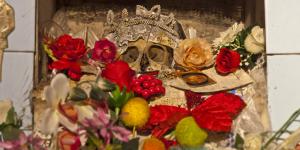
Adopting a capuzzella was also a response to suffering: it offered a channel for memory, a way to process grief, to give new meaning to loneliness. In many cases, it was also a form of resistance: against poverty, against the anonymity imposed by power, against the symbolic exclusion of official memory.
The cult of the ànime pezzentelle walks a fine line between popular religion and magical-symbolic practices. It is not officially recognized by the Catholic Church and has, in fact, been opposed at times. In the 1960s, ecclesiastical authorities banned the adoption of skulls and closed many crypts. But the cult survived—underground, like its locations—transforming, adapting, resisting.
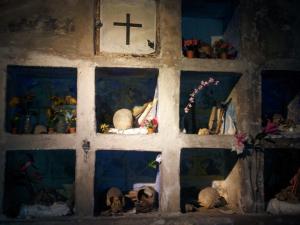
The Church has long viewed this form of popular piety with suspicion, considering it superstition. But for the people of Naples, the line between sacred and profane is much more porous. A miracle can happen in a street-corner shrine; a blessing can arise from the dream of a forgotten soul. Even death, if blessed with a gesture of affection, can speak again.
Beyond its spiritual aspects, the cult is also deeply material. The small altars built around the capuzzelle are filled with objects: rosaries, prayer cards, coins, dried flowers, tiny water bottles, candles, ex-votos, and slips of paper with lottery numbers. Each object holds symbolic value, and their accumulation recalls votive practices found in many religions worldwide.
In this sense, the anthropology of the gift (from Mauss to Godelier) finds a fascinating case here: the gift is not merely a religious act, but a strategy for building social bonds—even between the living and the dead. Giving something to a soul means including it in a circuit of exchanges, obligations, and reciprocity.
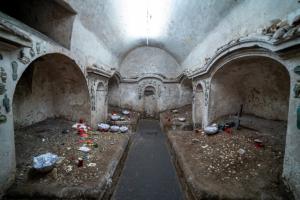
To adopt a skull is, ultimately, an act of symbolic justice. It means restoring a name to the nameless, memory to the forgotten, dignity to the marginalized. In a society that tends to erase death, Naples reintegrates it, places it at the center, adorns it. The cult of the ànime pezzentelle shows us that memory is not just preservation of the past, but active construction of the present through dialogue with the invisible. It is also a political act: remembering the forgotten is a way of challenging imposed hierarchies, rewriting history from below, transforming exclusion into connection.
In recent years, the cult has gained new visibility thanks to tourism. Guided visits to the Fontanelle Cemetery are in high demand, and some of the better-known skulls have become almost “spiritual celebrities.” But despite the risk of folklorization, the cult remains alive.
Alongside the curious tourist, there is still the woman who leaves a flower, the young person who lights a candle, the old man who whispers a prayer. New forms of devotion—sometimes hybrid—but always capable of keeping the dialogue with the beyond open.
Some contemporary spiritual groups, particularly those interested in recovering ancestral cults, see the ànime pezzentelle as an example of subtle communication, a model of alliance with the invisible. In an age when many are searching for new forms of meaning and belonging, the Neapolitan cult offers a framework for cultural resistance and an anthropology of the everyday.
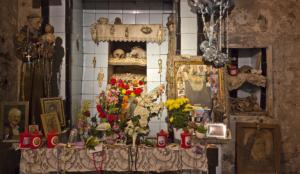
The ànime pezzentelle tell another story of Naples: an invisible Naples, made of silences, whispers, and small gestures full of meaning. They are the dark and compassionate face of a city that does not forget, that rejects oblivion, that transforms sorrow into ritual, and death into relationship.
For anthropologists, this cult is a living laboratory: of death, memory, gifting, female rituality, and the negotiation between official religion and popular spirituality. But even for citizens, travelers, or believers, the cult of the ànime pezzentelle remains a transformative experience.
It teaches us that piety is not weakness, but a higher form of justice. That the forgotten can become family. And that death, if welcomed and accompanied, can teach us more than life.
Lea la versión original en español aquí
Guest contributor, Luciano Martucci, is an Italian anthropologist and ethnographer who studies shamanism, folk healing, traditional medicine, and religion in Latin America. He is the author of El Gauchito Gil, de bandido a Santo and “Yo soy del San”: El culto a San La Muerte. Follow him on Facebook and Instagram.






